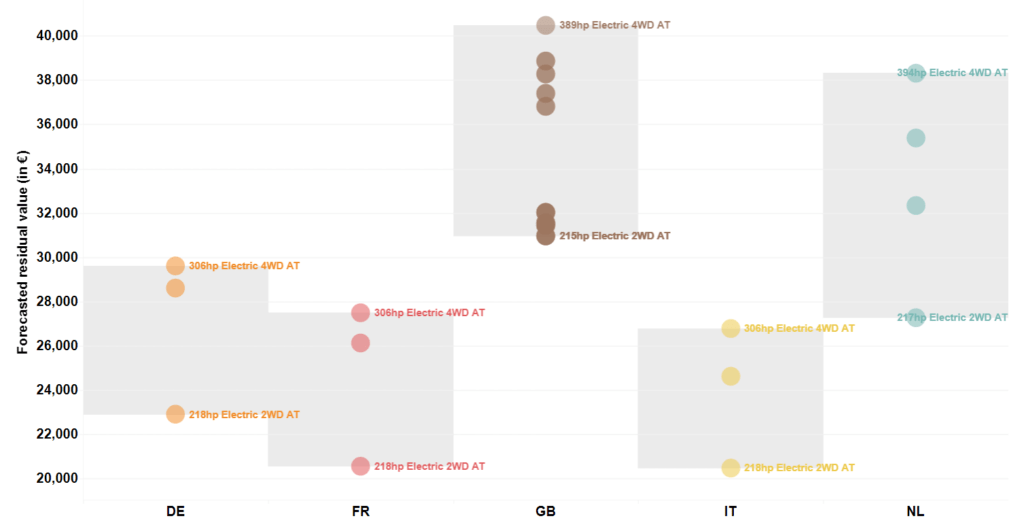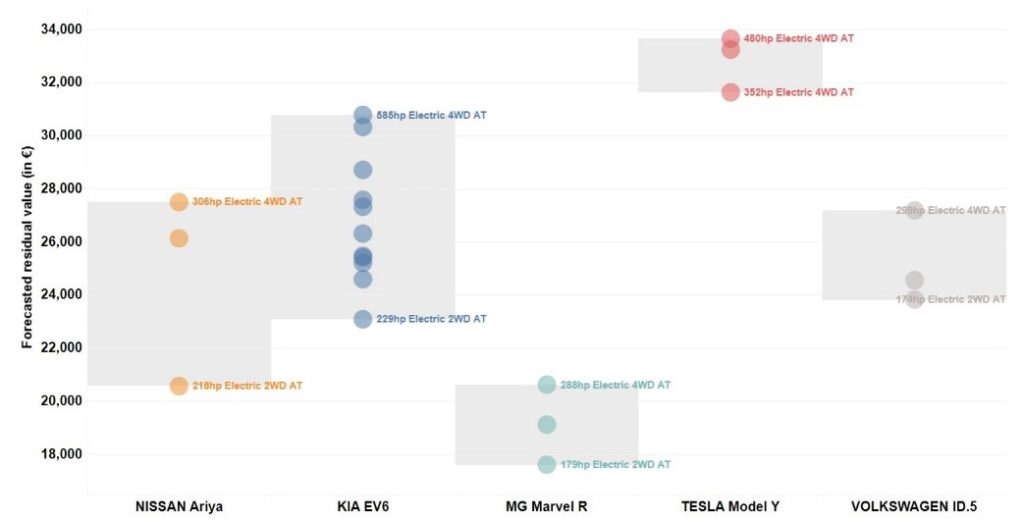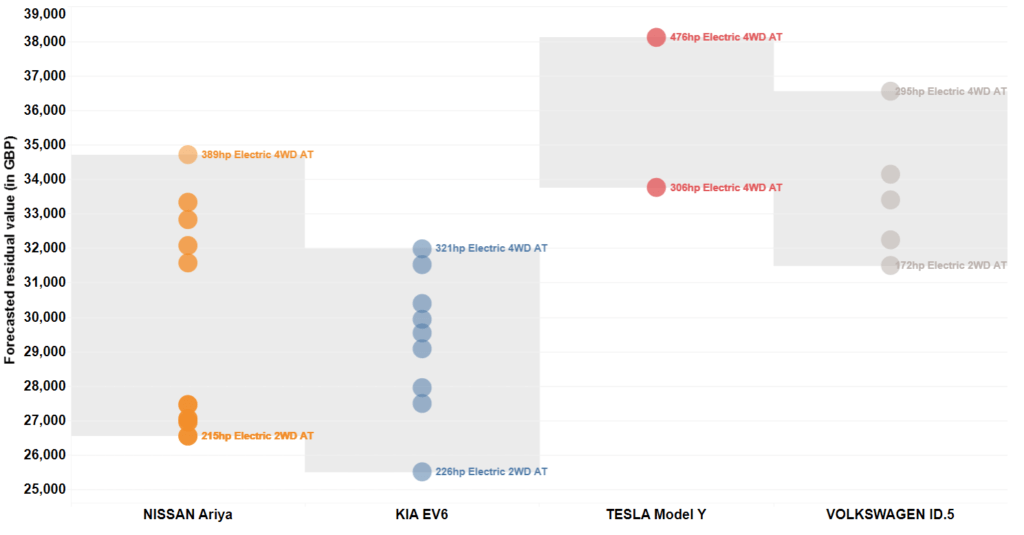Autovista24 principal analyst Sonja Nehls had a heart-to-heart with the new Nissan Ariya and gives a remarketing outlook.
It has been a long wait for Nissan’s second battery-electric vehicle (BEV) – the Nissan Ariya. It joins the many other launches into the competitive compact-SUV segment and still manages to stand out. An expressive exterior meets a minimalist, airy and sophisticated interior. The comprehensive standard equipment and large battery result in a steep list price, which does not fully wash through to residual-value (RV) performance.
Nissan Ariya remarketing potential
| Remarketing upsides | Remarketing downsides |
| Popular segment and body type | Competitive segment |
| Major leap in design, especially the interior | BEV specifications fall behind rivals |
| Comprehensive standard equipment | High list price |
Nissan took on a pioneering role in two major automotive developments in the recent past. The Nissan Leaf, presented in 2009, was the first mass-produced BEV. The Nissan Qashqai is commonly acknowledged as the first compact SUV, effectively launching a new segment. The new Nissan Ariya is the brand’s contribution to the fully-electric compact-SUV and crossover segment, which dominates carmakers’ launch activities at the moment and has become the sweet spot for electromobility.
The combination of product variety in the segment and general customer preference for SUVs and crossovers resulted in the fully-electric compact-SUV segment (SUV-C and SUV-D) growing its volumes to 359.283 units in 2021 – 14 times larger than in 2019. In the same timeframe, the overall BEV market in Europe almost quadrupled.
BEV Volumes in Europe, by segment, 2018-2021

Compact SUVs are popular, and the segment is very competitive, presenting a challenging market environment for the new Nissan.
With its size and body type, the Ariya takes on the likes of the European Car of the Year 2022 Kia’s EV6, the newcomer MG Marvel R, the newest addition to the Tesla family, the Model Y, and the Volkswagen ID.5. The Ford Mustang Mach-E, the Volvo C40, Skoda’s Enyaq Coupé or the Hyundai Ioniq 5 are also relevant competitors.
Specifications and dimensions versus main rivals

Timeless Japanese futurism
The Ariya is not a pioneer like its famous ancestors, but it does stand out from the crowd. The design is modern and clean with a well-balanced mix of contemporary features, such as slim headlights and a rear-light bar as well as a coupé-like roofline. This creates a design that will still be desirable when the Ariya enters the used-car market. The designers have achieved the goal they set themselves, which was to create a design summed up in three words: timeless Japanese futurism.
Opening the door of the Ariya does not only feel like opening a new chapter of Nissan’s story – it feels like opening an entirely new book.

The interior is a major leap forward for the brand and excites with its minimalistic style and horizontal lines. The capacitive buttons etched into the dashboard surface are a visual highlight and give haptic feedback. The two 12.3-inch screens are integrated into one solid piece that encompasses the driver and is reminiscent of the design of the aforementioned EV6.
However, the beautiful buttons are not as responsive as other carmakers’ solutions, while resolution and responsiveness of the screens also fall behind.

The car provides that airy feeling expected from a BEV. This was achieved by placing the climate-control system under the hood and introducing the power-sliding centre console to allow for more foot space in the front or the rear.
A modern gadget, which deserves an honourable mention, is the tray which appears from under the dashboard at the push of a button. It can be used to hold a laptop or tablet for entertainment when charging the car.
Charging speed cannot keep up
As charging specifications are below the benchmark values of Kia, Hyundai or Tesla, the potential of entertainment comes in handy to kill some time. With 130kW DC-charging capacity, the Ariya comes close to the ID.5, which is said to understate its abilities after the latest update and should be able to go up 170kW under ideal conditions.
Also, Nissan drivers will have to visit the charging station at least as often as Model Y and EV6 owners. The Ariya’s significantly bigger battery (87kWh) does not translate into a longer range due to the comparatively high consumption of 19.5kW per 100km.
BEV specifications vs. main rivals

On the road, the Ariya can rely on two different battery sizes, 63kWh and 87kWh, with a front-wheel drive set-up and a limited top speed of 160kph. The 87kWh is also available with all-wheel drive, a top speed of 200kph, and acceleration of 5.7 seconds from 0 to 100kph.
The e-Pedal mode, initially invented for motorsports and made famous by the Nissan Leaf, is also available albeit featuring a slightly different set-up. The creep mode cannot be switched off and the car will recuperate strongly, but not come to a full stop when the throttle pedal is released.
Standard equipment comes at a price
Nissan equips the Ariya with a comprehensive set of features, not only in its top variant with the Evolve pack, but also on lower trim lines. These features include a 360° parking camera, a hands-free tailgate, and an adaptive cruise control with steering assist, which for some of the rivals are not available at all, or are part of expensive packs and higher trim lines.
The configuration process for a customer is fast and simple as there is only a very limited range of optional equipment available. From a future used-car market perspective, this translates into a strong absolute €RV potential and transparency for buyers. So, the equipment set-up is not only comprehensive, but also smart.
All this equipment and technology comes at a cost, and it does not come cheap. The all-wheel-drive (AWD) version starts at €59.990 in Germany. The Evolve pack pushes the list price to €64.490. For reference, the 15cm longer Tesla Model Y Long Range with enhanced Autopilot costs €63.970.
List price prevents better RV positioning
The comparably high list price takes its toll on relative %RVs. The Nissan Ariya’s %RVs are the second-lowest among its competitors, only undercut by the MG Marvel R.
Absolute RVs are closer to rivals, especially the Kia EV6 and Volkswagen’s ID.5, as the comprehensive standard equipment is already reflected in €RVs.
In Germany, France and Italy, €-RVs range between €20.000 and €30.000 after three years and 60.000km, depending on the engine output, battery, and variant of the Nissan Ariya. In the UK, the overall surging RV level pushes €RVs close to £35.000 (just over €40.000). In the Netherlands, the Ariya benefits from a favourable environment for BEVs – new or used.
Nissan Ariya RV forecast, 36mth/60kkm, July 2022
Source: Autovista Group
Looking at the comparison to rivals in the French market, the Nissan Ariya keeps the MG Marvel R at a safe distance and draws level with the Volkswagen ID.5, and to some extent with the Kia EV6. The Tesla Model Y is the undisputed leader, as in most markets. Only in Germany can the Kia EV6 challenge the Model Y on €RVs.
Nissan Ariya RV forecast versus competitors, France, 36mth/60kkm, July 2022
Besides Jaguar Land Rover, Nissan is the carmaker with the highest production volumes in the UK. The Nissan Ariya can rely on a small domestic advantage for this reason, and comes closer to the Tesla Model Y with its absolute RVs, leaving the Kia EV6 behind.
Nissan Ariya RV forecast versus competitors, UK, 36mth/60kkm, July 2022
The interactive dashboard gives a more detailed cross-country overview and benchmarks the Nissan Ariya’s residual value and depreciation against comparable models in the markets.
The Nissan Ariya’s modern and expressive looks, the minimalistic and simply beautiful interior and comprehensive equipment, do not make it a pioneer in this very competitive segment, but it still does its ancestors justice.
The steep list price does support absolute RVs, but %RVs cannot keep up with most rivals.


 Close
Close


